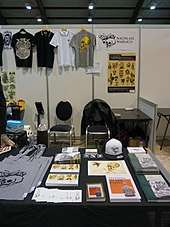Christian Warlich
Christian Warlich (January 5, 1891 – February 27, 1964) was a Hamburg based tattooist who professionalised tattooing in Germany. He supposedly was the first one to use an electric tattoo machine in Germany.[1][2]
Christian Warlich | |
|---|---|
| Born | January 5, 1891 |
| Died | February 27, 1964 |
| Occupation | Tattooist and Innkeeper |
Biographical and career information
Warlich was born and raised in Hannover-Linden. He left his parental home at the age of 14, went to Dortmund and reportedly became a boilermaker. He went to sea and might have had contact with tattooists in the US.[3] He got married in 1914 in Hamburg and opened a pub at Kieler Straße 44 (today Clemens-Schultz-Straße) around 1919. There was a separate area where he tattooed. His grandson and Theodor Vetter, a close friend of the family, worked as a business tout for Warlich.[4]

According to his own account Warlich tattooed „everything the male body should express […] politics, eroticism, athleticism, aesthetics, religion, in all colours, at every location.“ Though, in the context of a legal dispute about a face tattoo which was done by a competitor, Warlich claimed „a decent tattooer does not tattoo a face.“[5]
In over 40 years of working as a tattooist he had more than 50.000 customers, also Prince Axel and Prince Viggo from the Danish Royal family.[6] Warlich died at work in his pub.
After Warlich’s death Theodor Vetter (Tattoo Theo) took care of a part of the estate, the second part, including the famous flash book (Vorlagealbum) and photos, was sold to the Museum für Hamburgische Geschichte in 1965. So it was possible to show Warlich’s flash book in the exhibit „Wohin mit der Stadt“ in 2013. The Museum für Hamburgische Geschichte is planning to re-publish the Vorlagealbum, which was previously brought out by Stephan Oettermann. In 1981, he published the album with an accompanying text in cooperation with the museum. Although, over the next ten years, three editions of the volume were published, it is no longer available today. Oettermann’s publication was a groundbreaking and pioneering work. However, the low reproduction quality of the images do not entirely do justice to Warlich’s work. The quality of the original designs deviates strikingly from that of the reproductions. Therefore, a completely new and appropriate edition is planned.[7]
Research Projekt

The Hamburg-based art historian Ole Wittmann is the head of the current research project „Der Nachlass des Hamburger Tätowierers Christian Warlich (1891–1964)“ – also known as „Nachlass Warlich“ – which is carried out in cooperation with the Museum für Hamburgische Geschichte. Wittmann is a postdoc scholarship holder of the Hamburg Foundation for the Promotion of Science and Culture (Hamburger Stiftung zur Förderung von Wissenschaft und Kultur).[8][9]
See also
- List of tattoo artists
- official website of the project "Nachlass Warlich"
Selected bibliography
- Spamer, Adolf: Die Tätowierung in den deutschen Hafenstädten. Ein Versuch zur Erfassung ihrer Formen und ihres Bildgutes. Markus Eberwein und Werner Petermann, München: Trickster 1993, ISBN 3-923804-69-5; first publ. 1933 (in: Niederdeutsche Zeitschrift für Volkskunde, Nr. 11, 1933, Page 1–55; 129–182).
- Feige, Marcel: Tattoo-Theo: Der Tätowierte vom Kiez. Die Biographie der großen Hamburger Tattoo-Legende . Schwarzkopf & Schwarzkopf, 2001, ISBN 3-89602-355-1.
- Feige, Marcel: Ein Tattoo ist für immer. Schwarzkopf & Schwarzkopf, Berlin 2002, ISBN 3-89602-381-0.
- Wittmann, Ole: Tattoos in der Kunst. Materialität - Motive - Rezeption. Reimer, Berlin 2017, ISBN 978-3-496-01569-7.
- Bauche, Ulrich : Nachlass des Tätowierers Christian Warlich. Beiträge zur deutschen Volks- und Altertumskunde, 11. Bd. 1967, Page 107-108.
- Wittmann, Ole: Tattoo-Legenden“, Hamburg History Live, Nr. 2, 2016, Page 16–21.
- Heim, Heide: Der Heilige Gral“, TätowierMagazin, Nr. 248, Jg. 22, Oktober 2016, Page 74-83.
References
- Museum für Hamburgische Geschichte: Beiträge zur deutschen Volks- und Altertumskunde, 11-12. publ.: Museum für Hamburgische Geschichte 1967, Page 107.
- Stadtkind Hannovermagazin, Issue 7 / 2016, Page 44-49: Nadelstiche. Im Interview: Manfred Kohrs.
- Julika Pohle. "König der Stecher". DIE WELT (in German). Retrieved 2016-07-11.
- Marcel Feige: Das Tattoo- und Piercing Lexikon, Page 346–347.
- Schlange auf der Stirn Der Spiegel 10/1951
- "Christian Warlich". Tattoo Spirit vom 5. Mai 2014 (in German). Retrieved 2016-07-14.
- "Vorlagealbum | Nachlass Warlich". nachlasswarlich.de. Archived from the original on 2018-11-19. Retrieved 2016-12-13.
- "Nachlass Warlich. Forschungs- und Ausstellungsprojekt "Der Nachlass des Hamburger Tätowierers Christian Warlich (1890–1964)"" (in German). Retrieved 2016-01-22.
- Ole Wittmann. "Aufruf vom 30. Oktober 2015 /". Stiftung Historische Museen Hamburg/Museum für Hamburgische Geschichte (in German). Retrieved 2016-01-22.